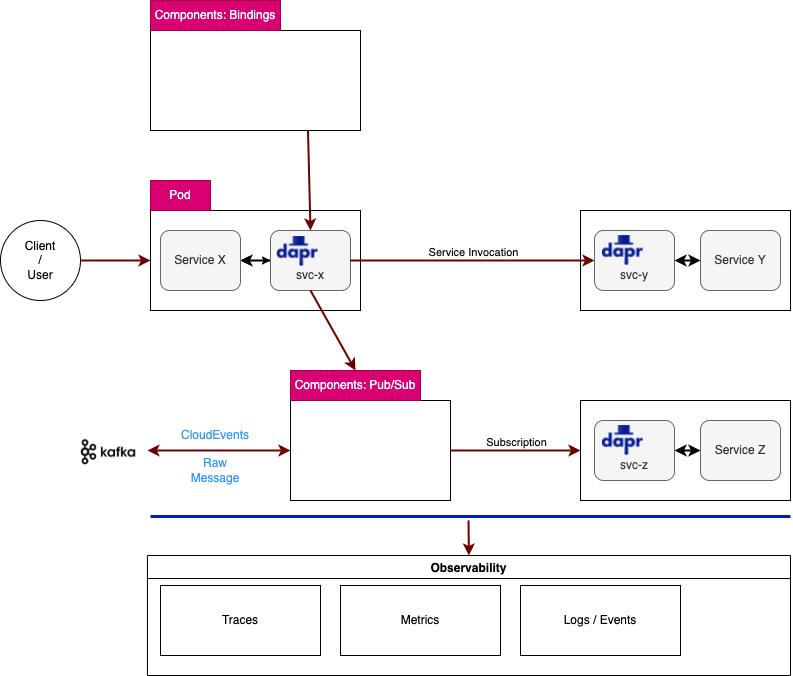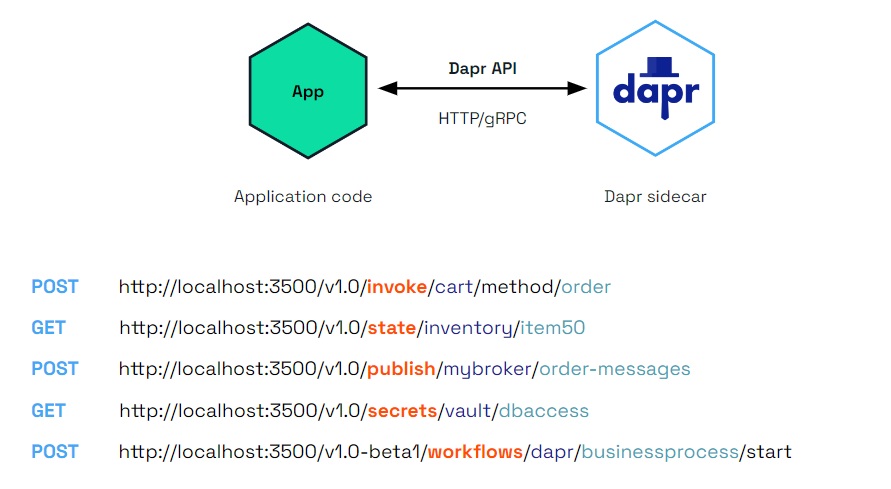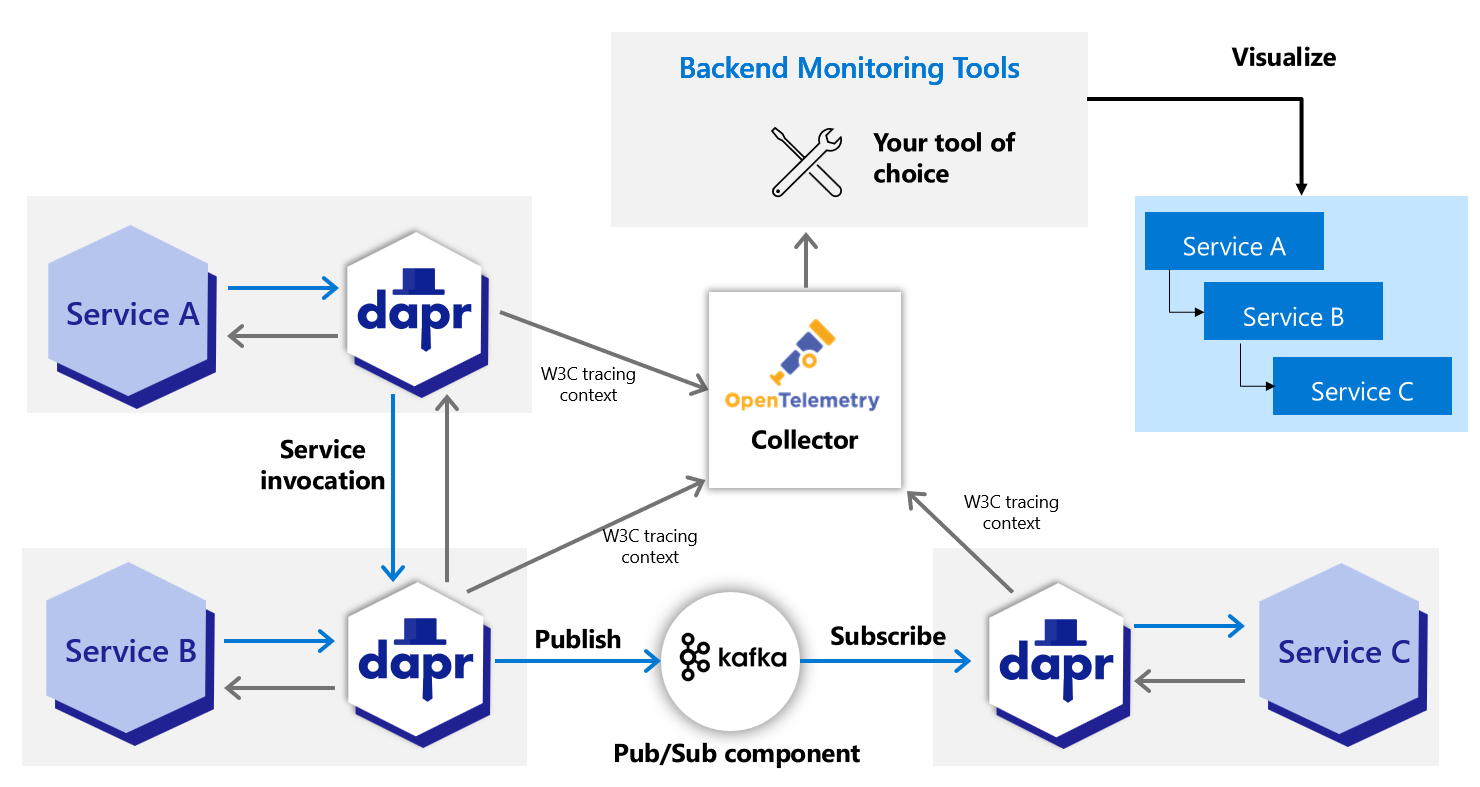Dapr?
Dapr is a portable, event-driven runtime that makes it easy for any developer to build resilient, stateless and stateful applications that run on the cloud and edge and embraces the diversity of languages and developer frameworks. Leveraging the benefits of a sidecar architecture, Dapr helps you tackle the challenges that come with building microservices and keeps your code platform agnostic.
# https://docs.dapr.io/getting-started/install-dapr-cli/
# Apple M1 (aarch64)
$ arch -arm64 brew install dapr/tap/dapr-cli
$ dapr --version
(snip)
Prerequisite:
- Docker
- Dapr CLI
- Helm
Self-hosted Dapr:
$ dapr init
or
$ dapr init --runtime-version 1.8.2
$ ls -als ${HOME}/.dapr/components/
Local Env. with kubernetes (Apple M1, k3s):
$ dapr init -k
Prerequisites:
- kubectl
- Helm
# Via CLI
$ dapr init --kubernetes --wait
# Via Helm (advanced)
$ helm repo add dapr https://dapr.github.io/helm-charts/
$ helm repo update
# See which chart versions are available
$ helm search repo dapr --devel --versions
$ helm upgrade --install dapr dapr/dapr \
--namespace dapr-system \
--create-namespace \
--set global.ha.enabled=true \
--set global.logAsJson=true
KEDA for Auto scaling:
$ helm repo add kedacore https://kedacore.github.io/charts
$ helm repo update
$ helm install keda kedacore/keda --namespace keda --create-namespace
https://docs.dapr.io/operations/configuration/
- Control plane Configuration
kubectl edit configurations/daprsystem --namespace dapr-system
-- Once the changes are saved, perform a rolling update to the control plane:
kubectl rollout restart deploy/dapr-sentry -n dapr-system
kubectl rollout restart deploy/dapr-operator -n dapr-system
kubectl rollout restart statefulsets/dapr-placement-server -n dapr-system
- Application Configuration
annotations:
dapr.io/enabled: "true"
dapr.io/app-id: "nodeapp"
dapr.io/app-port: "3000"
dapr.io/config: "myappconfig"
# Sidecar configuration
apiVersion: dapr.io/v1alpha1
kind: Configuration
metadata:
name: myappconfig
namespace: default
spec:
tracing:
samplingRate: "1"
httpPipeline:
handlers:
- name: oauth2
type: middleware.http.oauth2
secrets:
scopes:
- storeName: localstore
defaultAccess: allow
deniedSecrets: ["redis-password"]
accessControl:
defaultAction: deny
trustDomain: "public"
policies:
- appId: app1
defaultAction: deny
trustDomain: 'public'
namespace: "default"
operations:
- name: /op1
httpVerb: ['POST', 'GET']
action: deny
- name: /op2/*
httpVerb: ["*"]
action: allow
TBD
$ git clone https://github.com/dapr/quickstarts.git
$ cd quickstarts
# https://github.com/dapr/quickstarts/tree/master/tutorials/hello-kubernetes
$ cd tutorials/hellp-kuberntes
# state store (redis)
$ kubectl apply -f ./deploy/redis.yaml
## nodejs app with dapr sidecar
$ kubectl apply -f ./deploy/node.yaml
$ kubectl apply -f ./deploy/python.yaml
TBD
# Service invocation
curl http://localhost:3602/v1.0/invoke/checkout/method/checkout/100
try (DaprClient client = (new DaprClientBuilder()).build()) {
// invoke a 'GET' method (HTTP) skipping serialization: \say with a Mono<byte[]> return type
// for gRPC set HttpExtension.NONE parameters below
response = client.invokeMethod(SERVICE_TO_INVOKE, METHOD_TO_INVOKE, "{\"name\":\"World!\"}", HttpExtension.GET, byte[].class).block();
(snip)
System Architecture for PoC
A deployment for Dapr app.:
apiVersion: apps/v1
kind: Deployment
metadata:
name: dapr-demo
labels:
app: dapr-demo
spec:
replicas: 1
selector:
matchLabels:
app: dapr-demo
template:
metadata:
labels:
app: dapr-demo
annotations:
# dapr
# https://docs.dapr.io/reference/arguments-annotations-overview/
dapr.io/enabled: "true"
dapr.io/app-id: "dapr-demo"
dapr.io/app-port: "8080"
dapr.io/sidecar-listen-addresses: "0.0.0.0"
dapr.io/enable-api-logging: "true"
dapr.io/log-level: "debug"
#dapr.io/config: myconfig
(snip)
# HTTP
# GET/POST/PUT...
curl -X GET http://localhost:{DAPR_HTTP_PORT}/v1.0/invoke/dapr-demo/method/world/100
Prerequisites:
Pub/Sub flow with Dapr
A component "kafka-pubsub":
apiVersion: dapr.io/v1alpha1
kind: Component
metadata:
name: kafka-pubsub
namespace: default
spec:
type: pubsub.kafka
version: v1
metadata:
# https://docs.dapr.io/reference/components-reference/supported-pubsub/setup-apache-kafka/
- name: brokers
value: "my-cluster-kafka-bootstrap.kafka.svc.cluster.local:9092"
(snip)
$ kubectl get components
NAME AGE
kafka-binding 3h47m
kafka-pubsub 172m
Publishing a message to Kafka(via HTTP):
# pubsub.kafka
$ curl -X POST http://localhost:{DAPR_HTTP_PORT}/v1.0/publish/kafka-pubsub/test -H "Content-Type: application/json" -d '{"orderId": "100"}'
Subscribe to topics
Dapr provides two methods by which you can subscribe to topics:
Declaratively, where subscriptions are defined in an external file.
E.g.,
- https://github.com/dapr/samples/blob/master/pub-sub-routing/components/subscription.yaml
- https://docs.dapr.io/developing-applications/building-blocks/pubsub/howto-publish-subscribe/
@PostMapping(path = "/checkout")
public Mono<Void> handleMessage(@RequestBody(required = false) CloudEvent<String> cloudEvent) {
return Mono.fromRunnable(() -> {
try {
// Do something...
} catch (Exception e) {
throw new RuntimeException(e);
}
});
Programmatically, where subscriptions are defined in user code.
E.g., https://github.com/dapr/java-sdk/blob/master/examples/src/main/java/io/dapr/examples/pubsub/http/SubscriberController.java
Supported Bindings:
Specifying a custom route?
By default, incoming events will be sent to an HTTP endpoint that corresponds to the name of the input binding. You can override this by setting the following metadata property:
name: mybinding
spec:
type: binding.rabbitmq
metadata:
- name: route
value: /onevent
Kafka Binding:
https://docs.dapr.io/operations/hosting/kubernetes/kubernetes-production/
- HA
- TBD
- Auto scaling
- HPA or KEDA
- CI/CD
- TBD
- Exposing the services or APIs
- Exposing the Dapr APIs via Dapr-ized Nginx ingree controller
- https://carlos.mendible.com/2020/04/05/kubernetes-nginx-ingress-controller-with-dapr/
- https://www.atmosera.com/blog/kubernetes-dapr-and-azure-identity-example-part-v/
curl -k -H "Host: hydra" "https://<ingress ip>/v1.0/invoke/dni/method/api/validate?dni=54495436H" - Nginx IC "rewrite target"
- TBD
https://docs.dapr.io/operations/monitoring/
- Traces
https://docs.dapr.io/operations/monitoring/tracing/open-telemetry-collector/
Updating Components:
# Kubernetes
When running in Kubernetes, the process of updating a component involves two steps:
1. Applying the new component YAML to the desired namespace
2. Performing a rollout restart operation on your deployments to pick up the latest component
-
Pub-Sub vs. Binding ??
In general, pub-sub is for dapr-to-dapr communication. Bindings are for integration with external services.
-
dapr service on Kubernetes ??
-
Serverless(Function or FaaS) vs. Microservices
-
Dapr vs. Service Meshes(Linkerd, Istio...)
- https://dapr.io/
- https://docs.microsoft.com/en-us/dotnet/architecture/dapr-for-net-developers/
- https://blog.devgenius.io/sneak-peek-into-the-dapr-distributed-application-runtime-world-9dca2b76584b
- https://blog.devgenius.io/sneak-peek-into-the-dapr-distributed-application-runtime-world-9dca2b76584b#_Running_Example
- https://github.com/quarkiverse/quarkus-dapr
- Microservice Architecture
- https://charliedigital.com/2021/07/07/dapr-and-azure-functions-part-5a-deploying-to-aws-with-ecr-and-eks-fargate/
- https://github.com/Azure/dapr-java-workshop
- https://code.benco.io/dapr-store/
- https://www.youtube.com/watch?v=8age_72M_NE&t=1219s








